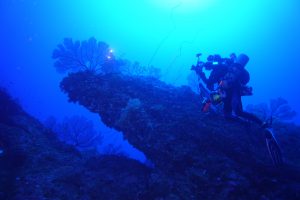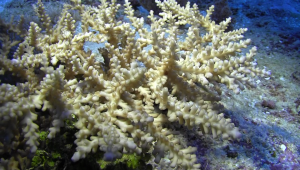We are investigating American Samoa’s mesophotic coral ecosystems (40–100 meters or ~130–330 feet deep) to better understand them and their relationship to shallower reefs. Nearly 80 percent of coral reef habitat in American Samoa exists at mesophotic depths, yet these reefs remain relatively unknown. Understanding what species exist and their habitat preferences at mesophotic depths will help managers improve management of current and future marine protected areas.

Why We Care
Coral reefs are among the most complex and diverse ecosystems on Earth. They provide goods and services that benefit human societies including food, cultural enrichment, employment, coastal protection, natural products, and recreation. Light-dependent reefs extend beyond shallow depths to over 150 meters in some areas, with the lower depth limit dependent on water clarity and location. The vast majority of research on coral reef ecosystems has focused on the shallow portion of these ecosystems (< 30 meters or ~100 feet), which only comprise ~20 percent of the total coral reef habitat. The other 80 percent of the total coral reef ecosystem, known as mesophotic coral ecosystems (MCEs), are relatively unknown and poorly understood in most regions.
With the overall health of shallow coral reefs in decline, it is important to understand the value and role of MCEs to the overall coral reef ecosystem, including whether MCEs can serve as a refuge for shallow species from threats or whether MCEs are more vulnerable. To improve our knowledge on MCEs in the South Pacific, this project targets American Samoa, the only U.S. Territory in the South Pacific. American Samoa is comprised of five volcanic high islands (Tutuila, Aunuʻu, Ofu, Olosega, and Tāʻu) and two atolls (Rose and Swains). Based on topography alone, there is more potential MCE habitat in American Samoa than known shallow coral reef habitat. Existing information about MCEs in American Samoa is limited.

What We Are Doing
We are characterizing the MCEs across American Samoa from 40–100 meters and comparing this information to what is known about shallow reefs < 30 meters. We will document the diversity and abundance of corals, fishes, algae, and non-coral invertebrates at MCE depths, as well as habitat and water quality characteristics associated with these environments. We will also be looking at coral recruitment and species biodiversity through the use of Autonomous Reef Monitoring Structures or ARMS and coral settlement plates; identifying coral bleaching thresholds for mesophotic corals (i.e., what temperatures will cause the corals to expel their symbiotic algae which they depend on for nutrition); and using DNA shed into the water by organisms to determine species presence/absence. Together, this information will be used to develop quantitative habitat models that will help predict where MCEs occur across American Samoa.
To ensure that our project and its outputs are useful to American Samoa’s resource managers, we will work closely with managers to translate our results. The results of this study will provide an inventory of species at MCE depths, their habitat preferences, and abundances for key species as compared to what is known for shallow reefs. This information will help resource managers make informed decisions regarding current and future marine protected areas for shallow and mesophotic coral ecosystems.
This work is part of the Deep Coral Reef Ecosystem Studies (Deep-CRES) Program and conducted in collaboration with the NOAA Office of National Marine Sanctuaries and Office of Ocean Exploration and Research. It is led by Anthony Montgomery, U.S. Fish and Wildlife Service. Project partners include Ken Longenecker and Richard Pyle, Bernice P. Bishop Museum; Rob Toonen, Hawai‘i Institute of Marine Biology, University of Hawai‘i; Dan Barshis, Old Dominion University; and Randy Kosaki, NOAA Papahānaumokuākea Marine National Monument.
